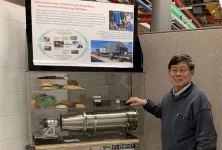(Press-News.org) URBANA, Ill. – As the world faces the challenges of mitigating climate change and providing resources for a growing population, there is increasing focus on developing circular economies for sustainable production. But to evaluate strategies and impacts, it is necessary to have reliable metrics. Researchers at the University of Illinois Urbana-Champaign have developed a Circularity Index that provides a comprehensive method to quantify circularity in bioeconomic systems. In a new paper, they outline the method and apply it to two case studies – a corn/soybean farming operation and the entire U.S. food and agriculture system.
“The traditional economic system is linear – we produce, distribute, use, and dispose of products. To increase sustainability, we need to develop a circular economy. Rather than just using natural resources, we must recover, reuse, and recycle waste materials,” said lead author Yuanhui Zhang, a professor in the Department of Agricultural and Biological Engineering (ABE), part of the College of Agricultural, Consumer and Environmental Sciences and The Grainger College of Engineering at the U. of I.
“Circular bioeconomy has become a hot topic in research, but most studies are merely descriptive and there’s no way to measure impacts. To move the technology forward, we need measurements to quantify effects, establish benchmarks, compare approaches, and identify weak spots,” he said.
In the paper, the researchers provide a step-by-step outline of the Circularity Index (CI), which measures circularity on a scale from 0 to 1. Zero means the system is completely linear, and 1 means it is completely circular. The index includes eight categories: take, make, distribute, use, dispose, recover, remake, and reuse. The CI is computed by entering available data into each of these categories.
Zhang and his colleagues demonstrate how to use the CI in two case studies. The first examines nitrogen cycling in a corn-soybean farm in the Midwestern United States. The researchers enter production and output data for a period of 8 years, and compare the effect of two different fertilizer treatments: urea versus manure. They calculate the CI to be 0.687 for urea and 0.86 for manure, indicating the use of manure fertilizer provides a more circular economy.
In the second case study, Zhang and his colleagues look at the U.S. food and agriculture system, focusing on energy use. Drawing on national data from the USDA, EPA, and DOE, they compare the current system with an approach based on the Environment-Enhancing Food Energy and Water System framework, which involves recovery, remake, and reuse of organic waste. They find the existing system has a CI of 0.179, while the EE-FEWS approach would lead to a CI of 0.84.
“Our current production system relies primarily on fossil fuel, with some use of solar and wind energy. But there is very little recovery of biowaste. If we recover food waste and manure and turn it into energy and fertilizer, we can recycle it back to the agricultural systems it originates from. Employing the EE-FEWS framework would greatly improve circularity of the U.S. bioeconomy,” Zhang explained.
The CI is a scalable method that can be used on different resource types and systems, depending on the focus of interest. Resources can be minerals, such as carbon or nitrogen, or non-mineral, such as water or energy. Systems can range from a process or a farm to an industry sector, a national economy, or even the global economy.
“We know it’s important to reduce fossil fuel use, increase renewable resources, and minimize our water consumption. But to do so effectively, we need to know how much, and what the weak links and tradeoffs are. The CI provides a single number that allows you to establish a baseline, compare systems, and determine best strategies for action,” Zhang said.
The CI can serve as an indicator to support policy initiatives such as the United Nations’ Sustainable Development Goals. It also has potential commercial value; for example, food companies can demonstrate their production circularity to consumers.
The paper, “A scalable index for quantifying circularity of bioeconomy systems,” is published in Resources, Conservation and Recycling [DOI: 10.1016/j.resconrec.2024.107821]. Authors are Yuanhui Zhang, Sabrina Summers, James Jones, and John Reid.
END
Illinois researchers develop index to quantify circular bioeconomy
2024-08-19
ELSE PRESS RELEASES FROM THIS DATE:
Less severe forest fires can reduce intensity of future blazes
2024-08-19
Not all forest fires have devastating effects. Low- and moderate-severity forest wildfires can reduce the intensity of future conflagrations for as long as 20 years in certain climates, according to new research by the University of California, Davis.
The extent of reduced severity of these second fires, or reburns, and the duration of the moderating effect, varies by climate, forest type and other factors. But initial fires continue to mitigate future severity even during extreme weather, such as wind, high temperatures and drought, research published in the journal Ecological ...
Electric reactor could cut industrial emissions
2024-08-19
Currently, industrial processes in the U.S. account for approximately a third of the country’s carbon dioxide emissions – even more than the annual emissions from passenger vehicles, trucks, and airplanes combined. Decarbonizing this sector is a challenging but vital step in mitigating impacts on our future climate.
Researchers at Stanford Engineering have designed and demonstrated a new type of thermochemical reactor that is capable of generating the immense amounts of heat required for many industrial processes using electricity instead of burning fossil fuels. The design, published Aug. ...
Causal relationship between PECAM-1 level and cardiovascular diseases
2024-08-19
https://www.scienceopen.com/hosted-document?doi=10.15212/CVIA.2024.0032
Announcing a new article publication for Cardiovascular Innovations and Applications journal. Platelet endothelial cell adhesion molecule (PECAM-1) is present in the vascular endothelium and plays important roles in various biological processes. Several recent studies have reported associations between PECAM-1 and certain subtypes of cardiovascular diseases (CVDs). However, further research is necessary to clarify the causal effects of PECAM-1 on CVDs.
To determine whether PECAM-1 and CVDs are causally ...
The plausible role of vascular adhesion molecules in cardiovascular diseases
2024-08-19
https://www.scienceopen.com/hosted-document?doi=10.15212/CVIA.2024.0046
Announcing a new article publication for Cardiovascular Innovations and Applications journal. Vascular Adhesion Molecules (VAMs) appear to play important roles in the development of Cardiovascular Diseases (CVD). The roles of these molecules in mediating inflammation, endothelial dysfunction, and plaque formation suggest that they may be important as both biomarkers and therapeutic targets. Understanding and targeting these molecules are hoped to substantially contribute to ...
Whole-exome sequencing identifies three novel TTN variants in Chinese families with dilated cardiomyopathy
2024-08-19
https://www.scienceopen.com/hosted-document?doi=10.15212/CVIA.2024.0040
Announcing a new article publication for Cardiovascular Innovations and Applications journal. Dilated cardiomyopathy (DCM), a severe heart disease, is the leading cause of heart failure and sudden cardiac death worldwide. DCM is defined by a dilated and deficient systolic left ventricle (LV) and is a major risk factor for morbidity and mortality worldwide. DCM progression can be ascribed to genetic and non-genetic factors, including hypertension, infectious agents, toxins, and drugs.
Sarcomere genes play crucial roles in myocardial cells’ physical structure and physiological function. Various cardiomyopathies ...
Key biofuel-producing microalga believed to be a single species is actually three
2024-08-19
MEDIA INQUIRES
WRITTEN BY
Laura Muntean
Ashley Vargo
laura.muntean@ag.tamu.edu
601-248-1891
FOR ...
Simple alternative criteria identify people with the most to gain from lung cancer screening
2024-08-19
Embargoed for release until 5:00 p.m. ET on Monday 19 August 2024
Annals of Internal Medicine Tip Sheet
@Annalsofim
Below please find summaries of new articles that will be published in the next issue of Annals of Internal Medicine. The summaries are not intended to substitute for the full articles as a source of information. This information is under strict embargo and by taking it into possession, media representatives ...
For some older adults with kidney failure, dialysis may not be the best option
2024-08-19
Whether dialysis is the best option for kidney failure and, if so, when to start, may deserve more careful consideration, according to a new study.
For older adults who were not healthy enough for a kidney transplant, starting dialysis when their kidney function fell below a certain threshold — rather than waiting — afforded them roughly one more week of life, Stanford Medicine researchers and their colleagues found.
More critically, perhaps, they spent an average of two more weeks in ...
UC Davis Health develops a real-time action plan to help patients with lung disease cope with wildfire smoke
2024-08-19
A multidisciplinary team of UC Davis Health experts are calling on health systems to create wildfire preparedness action plans to support patients with preexisting respiratory diseases. They are urging providers to proactively put in place interventions to mitigate the effects of poor air quality from smoke.
Their article, published in the Journal of the COPD Foundation, identifies the needs of high-risk populations when affected by wildfire smoke. It outlines an action plan for health systems to help these groups with the burdens of poor air quality from wildfires.
“Patients ...
MIT study explains why laws are written in an incomprehensible style
2024-08-19
Legal documents are notoriously difficult to understand, even for lawyers. This raises the question: Why are these documents written in a style that makes them so impenetrable?
MIT cognitive scientists believe they have uncovered the answer to that question. Just as “magic spells” use special rhymes and archaic terms to signal their power, the convoluted language of legalese acts to convey a sense of authority, they conclude.
In a study that will appear in the journal of the Proceedings of the National Academy of Sciences, the researchers found that even non-lawyers use this type of language when asked to write laws.
“People seem to understand that there’s ...




